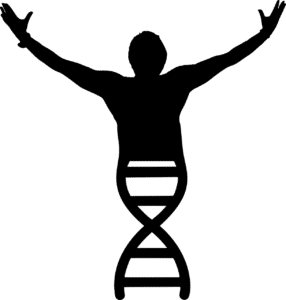Maximize Muscle Gains By Changing Your Genetic Make Up
October 23, 2017
Guest Post by Dr. Sharon Ricardo, Professor at Monash University, Australia
The latest scientific evidence suggests you can regulate your genes to promote muscle growth.
The gains are permanent and are even passed onto your children.
Here’s how it happens and why it matters to people who want to get big.
We begin with…
How Exercise Can Alter DNA
Your genes are determined at birth and define a number of your physical characteristics. These include your ability to gain muscle mass, the proportion of slow and fast twitch muscle fibers you have, your stamina, and your ability to gain fat.
However, what’s passed down from your parents is only half the biological story. That’s because new evidence suggests that environmental influences control genes.
These environmental factors, which can include how you exercise, have the power to make genes switch on and off. The operation of the gene is altered, but the DNA blueprint remains unchanged.
This means that your DNA can be influenced in a positive way through resistance exercise, or weight training. Alteration of your DNA as a result of exercise can switch on genes permanently and lead to more lean muscle gain, improved power, and performance.
The Role of Epigenetics
This process by which biological signals affect the expression of our genes is called epigenetics. If your genes are the hardware, epigenetics (epigenomes) are the software. It has the ability to update and remodel based on how it’s programmed. It does this by altering the types of proteins produced.

And if you think that’s crazy, what’s more astonishing is that the traits acquired during a lifetime and changes in genes can be passed down to future generations too!
Even as you’re reading this and prepping for your next gym session, you’re influencing the software of your future kids.
It’s well known that you’ll respond differently to strength and conditioning training compared to others.
You’re an individual with your own genes and your own epigenetic software.
What The Latest Research Shows

A new study has shown that although your underlying genetic code remains unchanged, exercise can induce immediate changes in muscle DNA. And these gene expressions result in beneficial responses elsewhere in the body (1).
This study showed that even a short period of exercise is enough to induce changes in the gene expression of skeletal muscle \and that in itself is responsible for the adaptive responses to exercise. Even more exciting is that we are just beginning to understand the epigenetic mechanisms involved in this process.
How Is This Useful?
This cutting-edge research shows that even muscle contraction from brief exercise can alter DNA both structurally and functionally. It essentially reprograms muscle to become stronger and increases the production of fat-reducing proteins.
Does this add to what we know about “muscle memory”?
A wide variety of biochemical changes occur during exercise. These include the production of proteins that help stabilize your blood sugar, reduction in fat uptake, and assistance with improving your physical performance.
What’s more, the anabolic response of muscle contraction results in an additive growth response. This has previously been termed ‘muscle memory’ and it may actually be due to the alteration of epigenetics that results in muscle adaptation over the long term (2).
This means that modified DNA resulting from exercise is retained throughout life.
Let’s call this epigenetic muscle memory
How Endurance vs Resistance Exercise Affects your Genes

The author, Professor Sharon Ricardo is a Research Group Leader in the Monash Biomedical Discovery Institute, Monash University, Australia. She has an established reputation in stem cells and organ development applied to development of novel therapies to prevent and reverse kidney disease, particularly diabetes and inherited kidney disease.
These new findings raise some fascinating issues:
(1) How does endurance training affect gene expression?
(2) Would it be different for strength training?
(3) What are the short-term and long-term benefits from both strength training and endurance training?
Clearly, all forms of exercise can induce positive changes that affect how we use our genes and provide more functional muscles to improve our overall state of health.
However, the magnitude of the response is determined mainly by intensity, volume, and frequency.
Increased evidence shows that predominantly focusing on mediocre endurance-type exercises, such as jogging, may under-maximize many of the most profound benefits of exercise.
In regards to the epigenetic effects of endurance training on muscle genes, a Swedish study was able to isolate the epigenetic effects of exercise from those of diet and recreational behaviors (3.)
Researchers recruited 23 young and healthy men and women and then asked them to exercise half of their lower bodies for 3 months. This entailed cycling using only one leg for a period of 45 minutes three times a week. The other leg was unexercised. The researchers took muscle biopsies after three months.
As expected, the exercised leg showed physical improvement. However genetic mapping showed that the muscle cells had more than 5,000 extra sites on the DNA compared to the unexercised leg. A majority of the gene changes that occurred in the exercised leg played positive roles in energy metabolism, insulin signaling, blood glucose control, and muscle inflammation.
What About More Intense Training?
 High-intensity interval training and strength training are more effective than endurance training in producing positive results in alteration of genes.
High-intensity interval training and strength training are more effective than endurance training in producing positive results in alteration of genes.
Why?
The rapid and deep level of muscle fatigue induced stimulates the muscle and DNA itself. Muscle and stem cells are also activated. (More about this later.)
Endurance training doesn’t provide this sort of stimulus.
Apart from muscle strength, regular resistance training has whole body benefits including effective regulation of blood glucose and circulating blood cells.
A recent study (4) showed that eight weeks of resistance exercise training (8-12 repetitions with a load equivalent to 80% of 1RM) had positive effects on blood cell DNA including growth hormone genes.
So Is Strength Training Better For Altering Genes?
In a word, yes.
Here’s a science-y explanation:
Maximizing the resistance exercise-induced anabolic response produces the greatest potential for muscle growth. It does this through muscle growth (hypertrophy) as a result of muscle fiber recruitment and anabolic signaling (5.)
Therefore, changes to exercise intensity, volume, and periodization result in specific muscular adaptations that can maximize the extent of muscle growth.
The stimulus for muscle contraction that occurs in response to resistance exercise is a major regulator for promoting muscle protein synthesis and muscle growth. This is a result of the cumulative effects of transient changes in gene expression.
How To Make Muscle Grow: Introducing Stem Cells
So how do you use all this information to alter your genetic ability to maximize potential and gain lean mass?
As we know now, genetic factors play a defining role in determining how much muscle mass a person has, as well as steady-state levels of endogenous anabolic hormones like testosterone.
 What’s more, your genes control your anabolic hormone levels, and the natural rate of muscle gain and progress over time. This process is also dependent on the ability of muscle stem cells to replace and repair muscle fibers.
What’s more, your genes control your anabolic hormone levels, and the natural rate of muscle gain and progress over time. This process is also dependent on the ability of muscle stem cells to replace and repair muscle fibers.
Although discovered in 1941, there has been limited mention of muscle stem cells in the bodybuilding arena. Otherwise known as satellite cells, these immature cells are retained after embryonic development. They then physically sit in a ‘stem cell niche’ at the periphery of muscle fibers.
Remarkably, muscle stem cells divide to replace muscle fibers and replace themselves indefinitely. They are almost immortal. They wait dormant, ready for cues from muscle contraction, where they then respond and activate to induce muscle hypertrophy from resistance training.
Muscle hypertrophy is due to the activation of stem cells and addition of cell nuclei to existing fibers. Not only that. Muscle stem cells also replace lost fibers and repair local muscle tissue in response to injury.
Muscle gain and repair is therefore directly the result of the stimulation of muscle stem cells.
Strength training also offsets the natural decline in stem cells and muscle mass.
Normally, the number of muscle stem cells you have reduces with age, resulting in a decrease in muscle mass, strength/power, and exercise capacity. However, the good news is that this process is preventable and reversible with long-term frequent resistance exercise.
In a recent study (6), isolated muscle stem cells from aged mice were transplanted into the leg muscle of young mice. At the time of transplantation, the aged muscle stem cells were deemed two thirds less able to function to replace muscle fibers and self-renew, compared to the younger counterparts.
However, following transplantation, the regenerative potential of the aged muscle stem cells was restored to their full potential and had renewed the ability to replace muscle fibers and promote muscle mass long term.
The Takeaway
The take-home message is that instead of asking what genes were passed down that pre-determine your athletic ability, you should ask how you can epigenetically regulate your genes to maximize muscle strength, conditioning, and fitness.
Muscle stimulation through exercise (as well as reducing your environmental exposure to toxins, such as excessive alcohol, high sugar diet, etc.) is crucial to maintaining the full regenerative potential of muscle stem cells.
What’s more, skeletal muscle stimulation in an anabolic environment provides a heightened capacity to respond to these later life stimuli.
Anabolic steroids positively alter gene expression by switching on new muscle fibers formed from muscle stem cells, resulting in long-term effects to enhance muscle mass. It does this over and above what has been genetically pre-determined.
Muscle response and epigenetic muscle memory to exercise is controlled, in part, by anabolic endocrine hormones including growth hormone (GH), insulin-like growth factor (IGF)-I, and testosterone (T). These hormones are involved in muscle adaptation to exercise as they promote muscle protein synthesis.
T and locally expressed IGF-I specifically have even been reported to activate muscle stem cells in more recent studies (7). Together, naturally produced GH and IGF-1 play important roles in mediating T’s anabolic effect on skeletal muscle.
To date, most research has focused on T and GH replacement. However, there is a lack of data on the activation of muscle stem cells and epigenetics following the administration of T levels in the cycling range. GH and T are anabolic agents that promote muscle protein synthesis and hypertrophy although working through separate mechanisms.
 It’s a matter of debate, but some studies suggest that the combined administration of GH and T, result in greater efficacy than either hormone alone. However, there is no doubt that amount of muscle gains and fat loss produced in response to T is unmatched.
It’s a matter of debate, but some studies suggest that the combined administration of GH and T, result in greater efficacy than either hormone alone. However, there is no doubt that amount of muscle gains and fat loss produced in response to T is unmatched.
For the natural gainer, when it comes to T levels everyone is different at baseline, as well as how T elevates in response to muscle load and frequency of training. The simple answer is this is genetically determined and influenced by epigenetics over time.
A recent study (8) used data modeling to confirm that 8 weeks of exercise-induced T production leads to muscle hypertrophy above levels of circulating cortisol, GH, IGH-1, and insulin responses to resistance exercise. Of course, muscle gain also requires adequate quality nutrients and protein to support growth.
However, injecting T above baseline levels heightens muscle hypertrophy due to protein accumulation as well as the formation of new larger muscle fibers. This, of course, depends on dose and cycle. There is now evidence that higher levels of T can stimulate muscle stem cell proliferation, and enhance the formation of new muscle cells. It does this from producing new fibers as well as fusion with existing fibers over the long-term in both young and older men (9).
More specifically, T stimulates muscle stem cell proliferation and fusion of stem cells into the pre-existing muscle fibers due to an increased need for protein synthesis. This process is a result of interactions between T and myostatin, (10) which is a protein that acts on muscle to control growth and maturation. It is also likely that T alters other cell types residing in the muscles that positively affect blood supply and regenerative potential of the supporting muscle matrix framework.
The Good News
Remarkably, this adaptability of the genetic influence towards lean muscle growth in response to T is considered permanent and is continued even after cessation of exercise.
Skeletal muscle is programmable and undergoes epigenetic changes to DNA in response to T allowing it to adapt to with additive muscle growth and maintaining improved muscle performance and metabolic function.
Something to think about the next time you hit the gym hard!
About The Author

Dr Sharon Ricardo is a Professor at Monash University, Australia, and is an internationally recognized expert on stem cells and organ regeneration. She is a previous bodybuilding competitor and exercise enthusiast with 20 years’ experience in the field. Follow Sharon on Instagram.
References:
- Barres R, Yan J, Egan B, Treebak JT, Rasmussen M, Fritz T, et al. Acute exercise remodels promoter methylation in human skeletal muscle. Cell Metab. 2012;15(3):405-11.
- Sharples AP, Stewart CE, Seaborne RA. Does skeletal muscle have an ‘epi’-memory? The role of epigenetics in nutritional programming, metabolic disease, aging and exercise. Aging Cell. 2016;15(4):603-16.
- Lindholm ME, Marabita F, Gomez-Cabrero D, Rundqvist H, Ekstrom TJ, Tegner J, et al. An integrative analysis reveals coordinated reprogramming of the epigenome and the transcriptome in human skeletal muscle after training. Epigenetics. 2014;9(12):1557-69.
- Denham J, Marques FZ, Bruns EL, O’Brien BJ, Charchar FJ. Epigenetic changes in leukocytes after 8 weeks of resistance exercise training. Eur J Appl Physiol. 2016;116(6):1245-53.
- Gonzalez AM, Hoffman JR, Stout JR, Fukuda DH, Willoughby DS. Intramuscular Anabolic Signaling and Endocrine Response Following Resistance Exercise: Implications for Muscle Hypertrophy. Sports Med. 2016;46(5):671-85.
- Cosgrove BD, Gilbert PM, Porpiglia E, Mourkioti F, Lee SP, Corbel SY, et al. Rejuvenation of the muscle stem cell population restores strength to injured aged muscles. Nat Med. 2014;20(3):255-64.
- Giannoulis MG, Martin FC, Nair KS, Umpleby AM, Sonksen P. Hormone replacement therapy and physical function in healthy older men. Time to talk hormones? Endocr Rev. 2012;33(3):314-77.
- Mangine GT, Hoffman JR, Gonzalez AM, Townsend JR, Wells AJ, Jajtner AR, et al. Exercise-Induced Hormone Elevations Are Related to Muscle Growth. J Strength Cond Res. 2017;31(1):45-53.
- Serra C, Tangherlini F, Rudy S, Lee D, Toraldo G, Sandor NL, et al. Testosterone improves the regeneration of old and young mouse skeletal muscle. J Gerontol A Biol Sci Med Sci. 2013;68(1):17-26.
- Dalbo VJ, Roberts MD, Mobley CB, Ballmann C, Kephart WC, Fox CD, et al. Testosterone and trenbolone enanthate increase mature myostatin protein expression despite increasing skeletal muscle hypertrophy and satellite cell number in rodent muscle. Andrologia. 2017;49(3).








